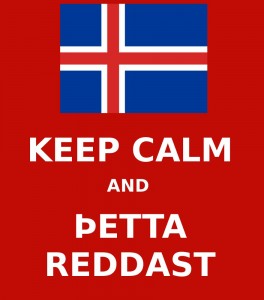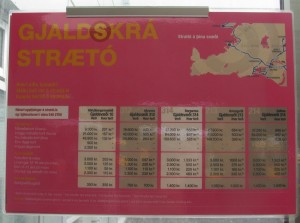Suffix to say don’t panic. Posted by hulda on Feb 6, 2014 in Uncategorized
 There’s a magic trick to learning Icelandic that I’d like to share with you today, and I guarantee that learning its basics will broaden your vocabulary skills in one go. Sounds too good to be true? Well, I’d say Icelandic is such a difficult language that using all the cheats you can find is not only allowable but also advisable: use your studying energy wisely on the parts where it’s most desperately needed instead of blowing it on the parts where you can get an easy way out.
There’s a magic trick to learning Icelandic that I’d like to share with you today, and I guarantee that learning its basics will broaden your vocabulary skills in one go. Sounds too good to be true? Well, I’d say Icelandic is such a difficult language that using all the cheats you can find is not only allowable but also advisable: use your studying energy wisely on the parts where it’s most desperately needed instead of blowing it on the parts where you can get an easy way out.
What I’m talking about here are the aðskeyti (= affixes). Icelandic words are built around a stem, or rót (= root), which means that one part of the word that is not possible to break into smaller morphemes. The other parts are called forskeyti, viðskeyti and inskeyti. There are two more, umskeyti and simulfix, but of these umskeyti (= circumfix) does not exist in Icelandic language, it’s simply a translated grammatical term to explain the phenomena in other languages and simulfix, being a sound/spelling change within the stem, can be better discussed when we get to A-víxl, B-víxl and C-víxl, also known as hljóðbreyting (= sound change). However, for now it’s enough to look at the main parts only. Inskeyti (= infix) can also be counted among hljóðbreyting in Icelandic, so I’ll leave that for later as well.
Rót/stem
Every single word needs a stem, and those parts of the word that cannot exist on their own are not stems; in Icelandic a stem has only one syllable, f.ex. hest-ur (= horse; hest = stem, -ur = male gender ending). The good news is that as long as you learn the stems you can both understand and create an unlimited amount of words! Every word has only one stem with the exception of compound words.
Forskeyti/prefix
Like its name suggests this affix goes in front of a rót and exists in English as well. In Icelandic it’s always just one syllable and does not change according to gender, amount or case. Forskeyti are few and their purpose in most times is to either stress or disagree with the rót, such as the forskeyti ó- that changes the meaning to its opposite such as vinur – óvinur (= friend – enemy).
Common forskeyti are f.ex.
Aðal– (= main, the most, the leading: dyr = door, aðaldyr = front door, maður = man/person, aðalmaður = main person, central figure)
Al– (= all, totally, completely): eiga = to own, aleiga = possessions, einn = one/sole/alone, aleinn = all alone)
For– (= most typical meaning is pre- something, other meanings exist: dóma = to judge, fordomur = prejudice; fordyri = lobby)
Megin– (= main, of main importance: hluti = part/portion, meginhluti = main part)
Mis– (= failure of: skilja = to understand, misskilja = to misunderstand)
Ný– (= newly, freshly: fæddur = born, nýfæddur = newborn)
Ör– (= minimal: öreiga = bankrupt, öreigi = proletarian)
Viðskeyti/suffix
No big news here either if you know English grammar: viðskeyti goes after the rót. There are far more viðskeyti than forskeyti, and not all of them have a set meaning although some do. Their existence may change a word group, such as turning a verb rót into a noun or a noun rót into an adjective. Viðskeyti that appear at the end of a word are affected by the case, gender etc.
Examples of viðskeyti are:
-and-/-ar- (= changes verbs into nouns: nema = to learn, nem-and-i = student; to teach, kenn-ar-i = teacher)
-hátt- (= a way, habit, grammatical mood: boð-hátt-ur = imperative mood)
-leg- (= like the English -ly: vingjarn-leg-ur = friendly)
-leik- (= typical English equivalent would be -ness or -ship but you may have to think of the meaning as a bit wider than that: vera = to be/a being, veru-leik-i = reality)
-ing-/-ling- (= change both verbs and adjectives into nouns: teikna = to paint, teikn-ing = a painting; ungur = young, ung-ling-ur = a teenager/youth)
-ó- (= a slang/spoken Icelandic way of shortening words: strætisvagn = strætó; some of these words, like the aforementioned strætó are now almost official in the form – even the bus company uses ‘strætó’)
-st- (= turns verbs into middle voice verbs: segja = to say, segi-st = it’s said that)
-ug- (= very similar to -leg-: blóð = blood, blóð-ug-ur = bloody)
IMPORTANT: sometimes the male gender ending is added to form a basic form of a viðskeyti, such as -ugur or -lingur. Don’t let it confuse you, the male gender ending is no real part of a viðskeyti and must be dropped if talking about anything else than a male singular!
Wikipedia has more forskeyti (here) and viðskeyti (here) listed, but keep in mind the above point on the -ur ending.
Hulda recommends music
Páll Óskar, or Paul Oscar, is one of my earliest favourites and I don’t usually even like dance music that much! Regardless I was easily wooed by the good humour and general warmth of his sound – and let’s not forget that he caused a small scale scandal in Eurovision by having (by that-time standards) a super risky show. 😀
Gordjöss (link) and lyrics (link). There’s also a video on Youtube with lyrics included but it has some typos here and there.
Betra líf (link), lyrics here. This is one of my favourite music videos by him by the way – so campy, bright and happy!
Allt fyrir ástina (link), lyrics can be found here. Best one to dance to on live gigs. 😀
As an extra, this is the Eurovision show that was ooooh so naughty in 1997. Jump to 1:05 if you want to skip the usual blahblahblahs.
All photos in this entry belong to me.

Build vocabulary, practice pronunciation, and more with Transparent Language Online. Available anytime, anywhere, on any device.
About the Author: hulda
Hi, I'm Hulda, originally Finnish but now living in the suburbs of Reykjavík. I'm here to help you in any way I can if you're considering learning Icelandic. Nice to meet you!







Comments:
corin:
Hae hulda,
Is it possible to get teletxt (= icelandic subtitles) for some programms i can stream on RUV such as tiufrettir or stundin okkar? there seems to be codes listed under the windows of some shows for the “page” they are on, but not sure how to activate or enter them, wherether by sms, via mobile phone or whateva, or if they cost? I can use the textavarp link to open a black window with the txt itself and an instruction to phone an icelandic number at the bottom for a taxi cab(?)!!!
any help would be much appreciated, cheers corin
hulda:
@corin I didn’t see anything via a quick look, but there has to be some way of getting the news with subtitles – I’ll see what I can find out about it!
The textavarp is more like a news page in text form only, in Finland a similar one is just called “text-tv”. It has all the main headlines with page numbering, and if you set in a page number with your remote control it shows you the whole news piece in writing. I’m not sure how it would work online though… :S
corin:
@hulda cheers